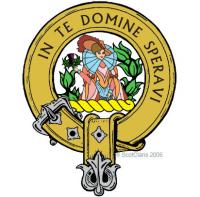
Clan Lyon
There are two trains of thought in regards to the origin of the Scottish surname of Lyon. Sir Iain Moncreiffe of that Ilk, perhaps the greatest herald genealogist, was of the opinion that his family were of Celtic origin and descended from a younger son of the Lamonts. However, it is now a generally accepted view that the Lyons of Scotland are descendents of the de Leons from Normandy in north France. De Leon came to Scotland to help Edgar, son of Malcolm III, in his fight against his uncle, Donald Bane, who wanted to take the throne at the end of the 11th century. Edgar triumphed over Bane, and de Leon, for his support, received lands in Perthshire, which should not be confused with Glen Lyon.
In 1105, a Roger de Leonne was witness to a charter of Edgar to Dunfermline Abbey.
Sir John Lyon, known as the White Lyon due to his fair complexion, was granted the thanage of Glamis, in 1372, by Robert II. Sir John was regarded in such high esteem that he was considered fit to marry Princess Johanna, the king’s daughter, sometime in 1376. The following year he became Chamberlain of Scotland (a position he would hold till his death). The marriage to Johanna brought the lands of Tannadice in Angus to Lyon, as well as an illustrious lineage for his children. On 4th of November, 1382 he was killed by Sir James Lindsay of Crawford during a quarrel near Menmuir in Angus.
From Sir John Lyon and Princess Johanna, the family have descended in a direct line to the present day; something their crest alludes to. Sir John’s only son, also John, was his successor, inheriting his titles and lands. John strengthed the royal ties by marrying a granddaughter of Robert II. In 1445 Sir John’s son, Patrick, was created Lord Glamis, and later became a Privy Councillor and Master of the Royal Household.
It is said that the sixth Lord Glamis, another John, was an argumentative person with a short temper. John married Janet Douglas, whose grandfather was the infamous Archibald Douglas, 5th Earl of Angus. James V had a strong hatred for the Douglas Earl, and all who bore the Douglas name. After Sir John Lyon died Lady Glamis was accused, on falsified charges, of witchcraft and, despite a strong and courageous self defence, her fate was already sealed. On 3rd December 1540 Lady Glamis was burned at the stake on castle hill in Edinburgh.
John Lyon, the eighth Lord Glamis withdrew his allegiance to Mary, Queen of Scots, and decided to serve the Regents Moray and Lennox instead. He was made Chancellor of Scotland and Keeper of the Great Seal for life, and his son Patrick, the ninth Lord, was captain of the Royal Guard and one of James VI's Privy Councillors. Patrick Lyon was created Earl of Kinghorne, Viscount Lyon and Baron Glamis in 1606.
John, the second Earl, was a close friend of James Graham, Marquess of Montrose; supporting him in 1638 when he subscribed to the National Covenant, and even helped Montrose in his first campaigns in defence of Covenant. However, Lyon’s beliefs and principles prevented him from following his great friend when the Marquess broke with the Scots Parliament to fight for the Royalist army of Charles I during the Civil War. But his support for the Covenant Army almost ruined Lyon financially.
When the second Earl died, his son Patrick, not only became the third Earl of Kinghorne, but he also inherited the debts his father had built up. However, Patrick spent years skilfully managing his estates and managed to pay off the debts, and later he built upon Glamis Castle, making it noticeably bigger. He gained a new title in 1677, and was known as the Earl of Strathmore and Kinghorne, Viscount Lyon, Baron Glamis, Tannadyce, Sidlaw and Strathdichtie from then on. Patrick died in 1695. His son John was a member of the Privy Council but he strongly opposed the 1707 Treaty of Union between Scotland and England.
John’s son, also John, became the 4th Earl in 1712. He was a Jacobite and fought during the 1715 rising at the Battle of Sheriffmuir. John was in Tullibardine’s regiment and died in battle defending his regiment’s colours. A year later, in 1716, James VII’s son, James Francis Edward Stuart, the Old Pretender, was entertained at Glamis. A different king’s son was entertained there 30 years later, but a much less welcome one. The Duke of Cumberland stopped at the castle on his march north to Culloden. Legend has it that after he left the bed that he had used was destroyed.
There are a number of Jacobite relics now preserved at Glamis Castle, and among them are a sword and watch belonging to the Old Pretender, as well as an intriguing tartan coat worn by him.
In 1900, the 14th Earl of Strathmore and Kinghorne’s youngest daughter, Elizabeth Bowes-Lyon, was born. She would be later known as Queen Elizabeth, the Queen Mother. Elizabeth’s youngest daughter, Margaret, was born at Glamis Castle in 1930.
The current Chief of Clan Lyon is Michael Fergus Bowes-Lyon, 18th Earl of Strathmore and Kinghorne.








